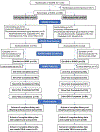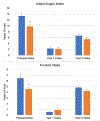Ethnicity modifies the relationship between added sugars and fructose exposure in the first 1000 days and offspring body composition at 24 months
- PMID: 40381608
- PMCID: PMC12202160
- DOI: 10.1016/j.nutres.2025.04.009
Ethnicity modifies the relationship between added sugars and fructose exposure in the first 1000 days and offspring body composition at 24 months
Abstract
Added sugars (AS) and fructose intake are linked to obesity. Hispanic populations experience high AS intake and obesity rates. It is underexplored if early sugars exposure influences offspring growth, especially across ethnic groups. This secondary analysis examined if AS and fructose intake during pregnancy, infancy, and toddlerhood influenced offspring adiposity at 24 months, and if ethnicity modified outcomes. We hypothesized that higher sugars exposure would predict increased adiposity. Mother-child pairs from a prenatal docosahexaenoic acid supplementation RCT and the offspring follow-up study were included. Dietary intake was assessed at 12 to 20 weeks gestation, and offspring intake at 2 weeks, 6 months, 12 months, and 24 months. Intake was averaged across infancy (Year 1: 2 weeks/6 months) and toddlerhood (Year 2: 12 months/24 months). Anthropometric (n = 130) and dual-energy X-ray absorptiometry (n = 42) data were collected at 24 months. Multiple hierarchical regression examined associations, with interaction terms testing ethnic differences. Higher AS intake in Year 1 predicted higher weight, fat-free mass, and total adiposity. Compared to non-Hispanic offspring, the association of Year 1 fructose intake with weight and Year 2 AS intake with fat-free mass and central fat mass, were weaker in Hispanic offspring. No other significant associations were observed. The relationships between early AS and fructose intake with body composition are dynamic over time and vary by ethnicity. Our findings highlight the potential risks of early sugars exposure on obesity and metabolic health, underscoring the need for further research to inform early-life dietary interventions and public health policies.
Keywords: 1000 days; Added sugars; Adiposity; Fructose; Hispanic; Infancy; Pregnancy; Toddlerhood.
Copyright © 2025 The Authors. Published by Elsevier Inc. All rights reserved.
Figures


References
-
- Bowman SA. Added sugars: definition and estimation in the USDA food patterns equivalents databases. J Food Compos Anal 2017;64:64–7. doi: 10.1016/j.jfca.2017.07.013. - DOI
-
- U.S. Department of Agriculture and U.S. Department of Health and Human Services. Dietary Guidelines for Americans, 2020–2025, https://www.dietaryguidelines.gov/; 2020. [accessed 18 October 2024].
MeSH terms
Substances
Grants and funding
LinkOut - more resources
Full Text Sources
Research Materials

